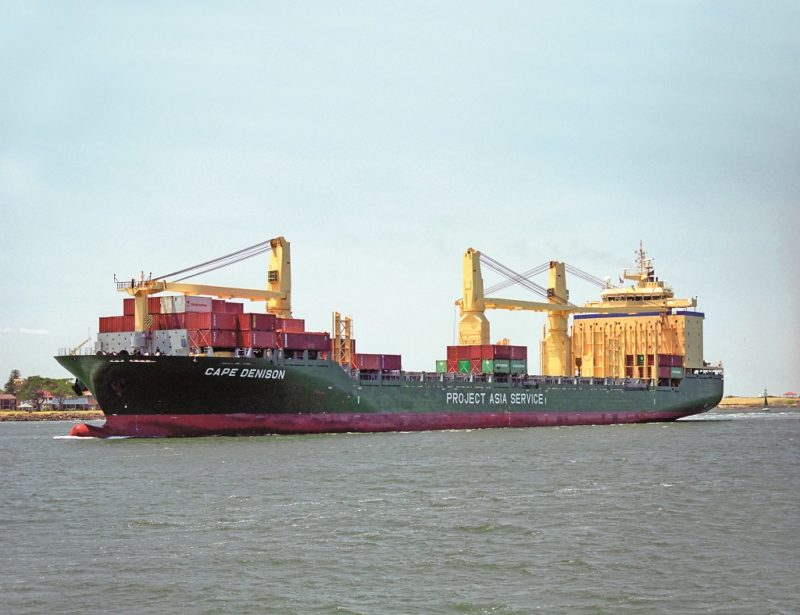
The Port of Newcastle (NSW) is administered by the Port Authority of New South Wales, along with five other ports of Sydney Harbour, Port Botany, Port Kembla, Port of Eden and Port of Yamba. The Port of Newcastle is a vital economic gateway to the mineral resource-rich Hunter Valley, with over 2,200 vessels per year visiting the port and exporting valuable cargo of coal with 163.8 million tonnes exported in 2019/20 representing 90% of throughput, and the remaining 10% of grain, vegetable oils, alumina, fertilisers, ore concentrates and other minerals to markets overseas. The Port Authority of New South Wales handles a giant 212 million tonnes of cargo per year worth $100 billion in trade from 5,940 commercial vessels passing through the six ports.
HISTORY of the PORT of NEWCASTLE
The Hunter River flows through Newcastle with the region traditionally occupied by the Awabakal and Worimi Aboriginal Peoples, who called the area Malubimba. The New South Wales Geographic Names Board has identified eight landmarks around the area with their English and Aboriginal names as follows:-
- Nobbys Head in the approach channel to the Port of Newcastle also known as –
- Whibayganba
- Flagstaff Hill (Tahlbihn)
- Pirate Point (Burrabihngarn)
- Port Hunter (Yohaaba)
- Hunter River South Channel (Coquun)
- Shepherds Hill (Khanterin)
- Ironbark Creek (Toohrnbing)
- Hexham Swamp (Burrahihnbihng)
In September 1797, Lieut. John Shortland became the first European settler to explore the area, with his discovery largely accidental as he had been sent to search for a number of convicts who had seized a locally built ship as she was sailing from Sydney Cove. He entered a large river and named it after John Hunter, the Governor of New South Wales. Coal was found and this was the first export of the new colony of New South Wales.
In 1800, more serious attempts were made to make Newcastle into a sustainable area with coal mining, logging and sawn timber. In 1804, the settlement was named Coal River and then Newcastle, after the most famous coal port in England. Lieut. Charles Menzies was appointed superintendent of the new Newcastle colony and he arrived on 27th March 1804 with three ships in the warship Lady Nelson, and the Resource and James. Many of the coal miners came from the North East of England, and gave their home town names of Stockton, Jesmond, Hexham, Wickham, Wallsend, Gateshead and Morpeth to the new settlements.
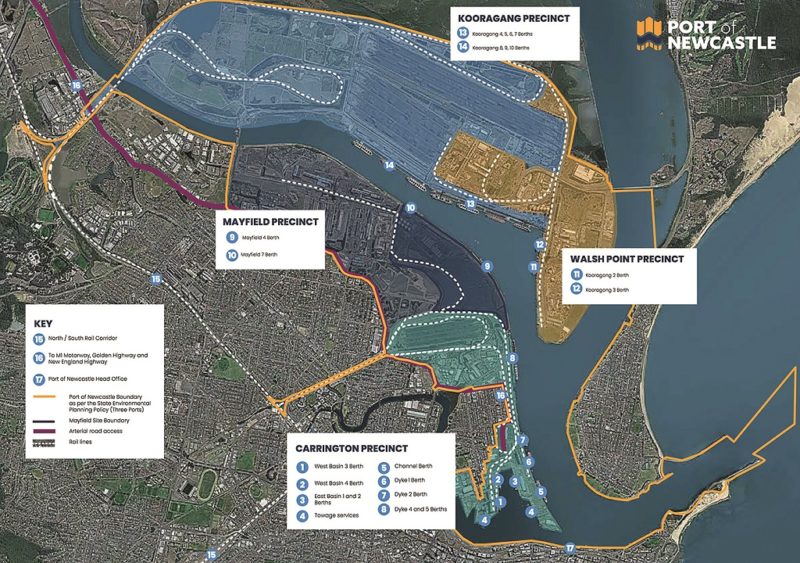
Military rule in the new colony ended in 1823, and it began to acquire the aspect of a traditional Australian pioneer settlement, with a steady flow of new settlers arriving. The first railway in Australia opened in 1831 at Newcastle to carry export coal to the wharves. Various schemes were planned to partly dredge the harbour or create an artificial harbour, but by 1911 the New South Wales Government finally considered it was cheaper to deepen the Newcastle harbour entrance than to consider any of the other options. The dredger Latona of 397 grt was built by the Cockatoo State Dockyard in 1911 at Sydney as one of the first of a fleet of twin screw dredgers to be built with names such as Neptune (1923), Hermes (1931), Jupiter (1912), and Tethys (1905) and worked with hoppers Grafton and Lismore built in 1917. The pilot boats at Sydney and Newcastle were Captain Cook of 396 grt built in 1893 and Birubi of 429 grt built in 1927.
A shipping company evolved in December 1891 from the merger of the Newcastle Steamship Company and the Hunter River New Steamship Company to connect the sixty miles distance northwards from Sydney Harbour to Newcastle as the Newcastle and Hunter River Steamship Company. Typical vessels were the fast passenger ships Namoi of 1,416 grt and Newcastle of 1,251 grt built by J. Key & Sons of Kinghorn in 1883/84, and engines ‘midships passenger and cargo ships in the Archer of 633 grt built in 1882 on the Clyde, the twin screw Hunter of 1,840 grt built in 1907 by Ramage & Ferguson of Leith with passenger accommodation for 242, the twin screw Gwydir of 1,848 grt and built in 1911 by D. & W. Henderson on the Clyde, and Kindur of 1,267 grt built in 1928 by the Ayrshire Dockyard Ltd., Mulubinba of 1,262 grt built in 1937 by Henry Robb Ltd. at Leith, Karuah of 1,353 grt built in 1950 by the Whampoa Dockyard Co. Ltd. at Hong Kong with Tyne built triple expansion engines, and the last coaster Edenhope of 584 grt built in 1949 by Walkers Ltd. of Maryborough. Services were discontinued in 1956, funnel colours were red with a black top, below which were a white band and a blue band. This fleet were known as ‘Sixty milers’ with early ships having First Class cabins and lit by the latest wonder of electricity, larger vessels traded to Brisbane and Melbourne.
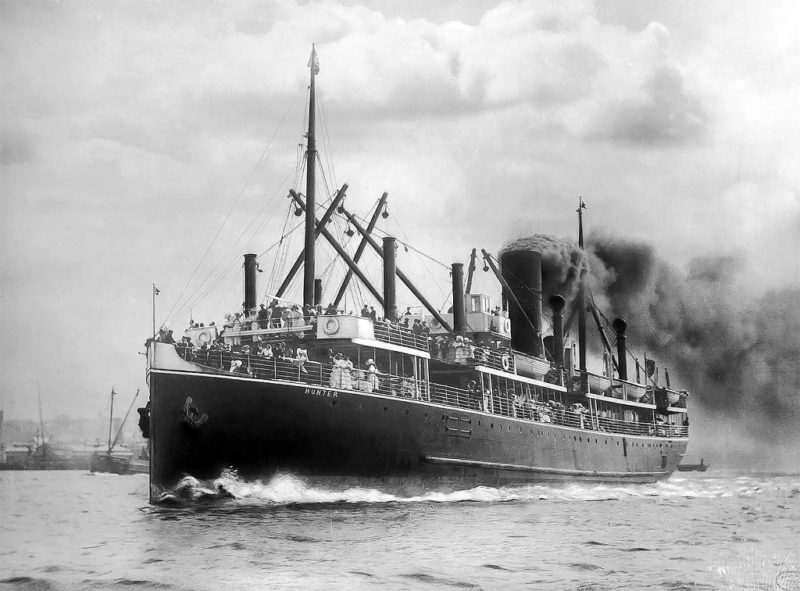
During World War II, Newcastle was an important industrial centre for the Australian war effort, and consequently was shelled by the Japanese submarine I-21 on 8th June 1942. The shells were well aimed to hit the dock area, the steel works, Parnell Place in the east end of the city, the Art Deco Ocean baths, and the breakwaters in the harbour at Nobbys Head. There were no casualties and little damage was sustained. Fort Scratchley, completed in 1886, defended the port in 1942 during this Japanese submarine attack, is now a military museum that has been restored and is open to the public. The breakwater where it stands borders Nobbys Beach with excellent shipping and harbour views, the breakwater was completed in 1846.
The Port of Newcastle is the oldest seaport in Australia, with a huge coal exporting total of over 160 million tonnes of coal per year, making it the second largest throughput tonnage port in Australia. Port Hedland in Western Australia has the largest throughput total, with vast exports of iron ore in Capesize bulkers to China and Japan. Port Hedland tonnage throughput, based on current growth, has the near future capability of 617 million tonnes of iron ore, lithium and salt exported per year.
In 1951, Kooragang Island was formed by joining and reclaiming three smaller islands. The harbour was deepened by suction dredgers in 1962, and four years later the Maritime Services Board began a development programme for the harbour, with the first industry then established on Kooragang Island. In 1967, the Basin Coal Loader began operations, followed in 1976 by the Port Waratah Coal Loader. In 1977, a $103 million harbour dredging programme began, which had deepened the main channel to 15.2 metres by 1982. The Kooragang Coal Loader 1 began operations in 1984, leading to it’s merger with the Port Waratah Coal Loader. General cargo facilities were revamped in 1995 at a cost of $1.6 million, and Kooragang Coal Loader 6 opened in 1998. The Vessel Traffic Scheme (VTS) opened in 2001 on the Newcastle Foreshore, having been transferred from the Nobbys Head Signal Station. The GrainCorp Agriterminal was opened in 2002 at Kooragang Island, with coal exports then running at 85 million tonnes per year, and record imports of alumina, cement, and iron and steel.
The Hunter River to the north of the Newcastle Golf Club has Smith’s Island and swings west to the North Channel Hunter River and the Hunter Wetlands National Park. The coal export terminals of Kooragang and Dyke are near Kooragang Island, formed by the South Channel Hunter River and the North Channel Hunter River. The Svitzer Maritime tug base is in the Throsby Creek, in an industrial area of crane manufacture, electrical and transport companies. There are currently nine Svitzer Maritime tugs in operation at Newcastle, three for each eight hour shift, named Svitzer Ginga, Svitzer Glenrock, Svitzer Larrakia, Svitzer Myall, Svitzer Newton, Svitzer Maitland and the Pacific Basin (PB) tugs PB Murray, PB Darling and PB Plenty. The fire fighting tug Wickham, named after a local suburb, is of 496 grt and was built in 1990 as R20 and was renamed in 1994. The BHP early ‘Iron’ ore carriers of the 1940s and 1950s were handled at Newcastle by the tugs Heroine and Heroic.
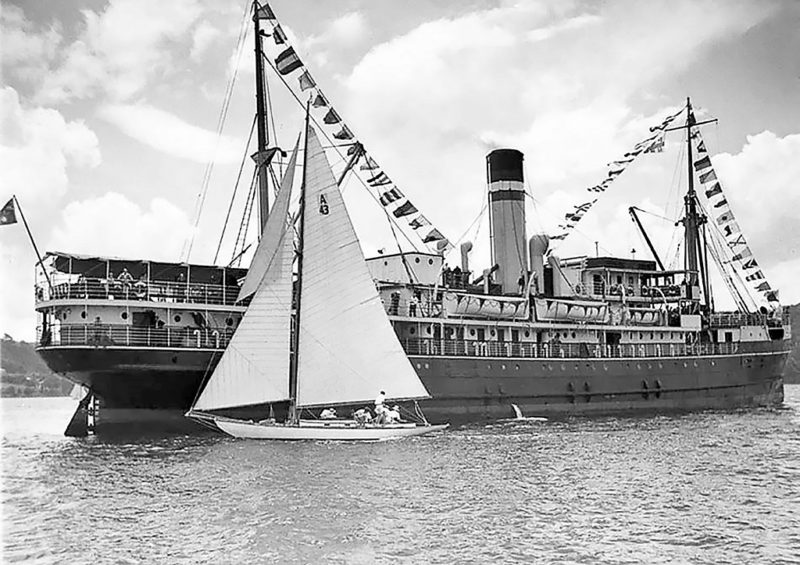
In 1999, there were two competing towage companies in the port. Hunter Towage Services had four tugs operating for BHP and an international group of shipowners, and four tugs operating for Adsteam Marine and Howard Smith, the latter two companies then amalgamating in 2001 as Adstream Marine. Svitzer Australia Pty Ltd. then took over Adstream Marine in 2006 and has since improved the Port of Newcastle towages services with the addition of nine new powerful tugs.
The Marine Services Board (MSB) was formed in 1936 to co-ordinate under one authority all the navigation services of all ports in New South Wales, the exception being Port Kembla, which was admitted to the MSB in 1948. In post-war years, the MSB fleet included the tugs A. R. Ford, Eva Burrows, Shirley Smith and Ted Noffs, and the survey and patrol ships New Investigator and Wauri.
The Newcastle Port Corporation was formed in July 1995 as a NSW State owned Corporation under the Ports and Maritime Administration Act of 1995. The port throughput trade in the year 1995/96 amounted to 56 million tonnes, with a channel depth of 16.5 metres and a berth alongside depth of 15.2 metres. A suction dredger was owned in order to maintain these depths at all times. Port Waratah Coal Services Pty Ltd. operated two coal loading terminals at Carrington and Kooragang with a total of four loading berths. A third private company was planning to establish in 1998 a coal loading terminal at Kooragang Island with a capacity of 28 million tonnes per year at two more berths. A further two loading berths were added in 2002 with additional loading heads at a cost of $700 million. In July 2014, the Port Authority of New South Wales was formed and took over Newcastle Port Corporation, with all of the other five New South Wales port operation authorities taken over by 2015.
There were 4.606 pilotage movements during 2019/20, of which 3,353 were carried out by helicopter and 1,212 by pilot cutter. Two weeks of severe flooding in March 2021 in the Newcastle area changed the salinity of the water in the harbour, with the Marine Pilots working harder to manoeuvre big ships, and requiring a higher degree of skill and patience in docking Capesize bulkers.
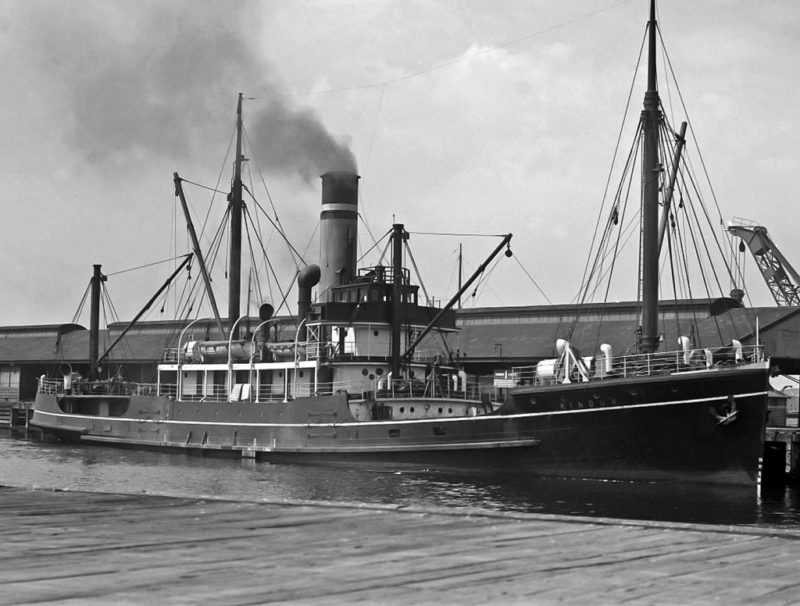
PRINCIPAL PAST AND PRESENT INDUSTRIES OF NEWCASTLE
STEEL MANUFACTURE
Broken Hill Proprietary (BHP) began mining silver, lead and zinc at Broken Hill in the western part of New South Wales in 1885. It was described as one of the most lucrative mining deposits in the world at that time, with silver fetching high prices on the world markets. In 1899, BHP leased an iron ore mine at Iron Knob in South Australia, and in 1915 it ventured into steel making and commissioned a huge steel works at Newcastle. Steel was cast for the building of ships, ammunition and guns during World War I. Fifteen iron ore carriers and bulkers were built by the Whyalla Shipyard in South Australia for BHP to transport iron ore to Newcastle from 1942 until the last pair were completed in 1977/78 as the sisters Iron Carpentaria and Iron Curtis of 45,430 dwt.
Over nearly nine decades until closure in 1999, the works employed generations of men as steelworkers, a tough industry with very loyal workers. However, by 1987, the works and the old steel rolling mills were losing money and could no longer compete in the world steel industry. There were five long iron ore unloading berths in the Port of Newcastle using giant ship unloaders and conveyor belts to transfer the iron ore to the blast furnaces. Berth BHP 6 is still in use today by Koppers Australia to load and unload high temperature bulk liquids such as tar and pitch. Some 50,000 steelworkers had been employed during the long period of steel making, with unemployment then increased from 8% to over 12% in 2000 in Newcastle. The giant ore carrier Iron Pacific of 315.0 metres overall length loaded 183,904 tonnes of coal at Kooragang Coal Terminal in 1996 as the largest vessel ever to enter an Australian port. BHP had a fleet of 22 ships of 1.90 million tonnes deadweight when the Newcastle Steel Works was closed.
In 2002 BlueScope Steel took over more than fifty steel facilities and distribution centres in Australia, employing 6,000 people with half of these employed at the steel works at Port Kembla. Self discharging ore carriers such as Iron Chieftain of 50,590 dwt are currently towed to the ore unloading wharf by three Svitzer tugs. Iron Chieftain was built in 1993 for BHP on dimensions of overall length 202.0 metres and moulded beam of 32.3 metres, but was sold in 2003 for $18.5 million to CSL of Canada and wears their funnel colours on a very long charter back to BHP.
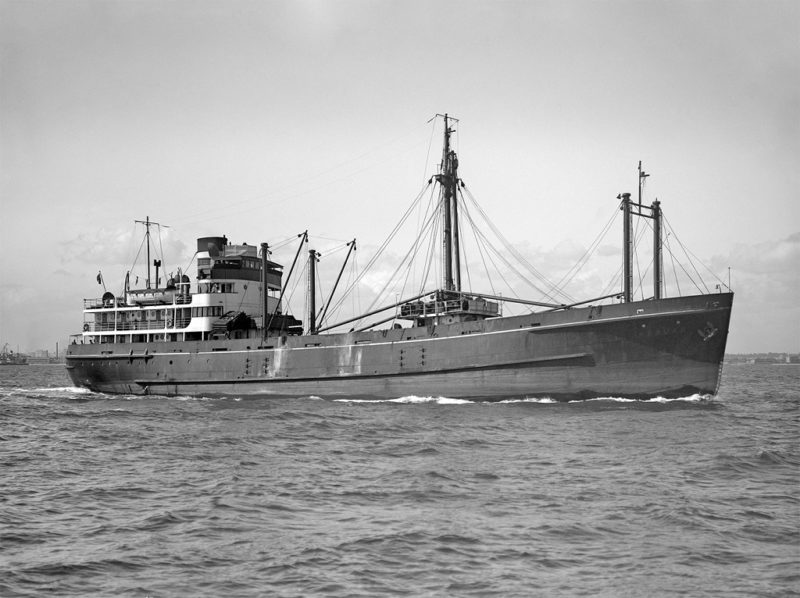
COAL MINING
Coal mining in the area began in earnest on 3rd May 1833 when the Australian Agricultural Company received land grants and a 31 year monopoly of the coal traffic. The collieries had typical names of Stockton, Tighes Hill, Carrington, Mereweather, Glebe, Wallsend and Waratah, but all surface shallow mining operations had ceased by the early 1970s in favour of the deep seam mechanised operations of today. However, since 2003 Australia has experienced a commodities boom for exports of coal and iron ore, leading to the Port of Newcastle now having a vast coal export trade of in excess of 100 million tonnes per year to Asian countries such as China, Japan and the Philippines.
The Brown family of Newcastle owned many collieries in the Hunter Valley and to the west of Newcastle from 1843 onwards, including the Hartley Vale Colliery, Minmi Colliery, New Lambton Colliery, Stanford Greta Colliery, Richmond Main Colliery, Richmond Vale Colliery, Pelaw Main Colliery, Stockrington Colliery, and the Newcastle Coal & Copper Company. Alexander Brown (1827-1877) and James Brown (1816-1894) were the main owning brothers of J. & A. Brown Ltd., which merged on 19th January 1931 with Abermain Seaham Collieries Ltd. with a capital of Australian $134,000. In 1960, the firm then merged with Caledonian Collieries to form the Coal & Allied Industries Ltd., which became a subsidiary of Rio Tinto in 2013.
A large fleet of J. & A. Brown Ltd. Interstate colliers was owned as well as the engines ‘midships ocean going collier Hexham of 2,931 grt and 4,750 dwt built as Amphion in 1911 and purchased in 1913 and renamed Hexham, and which traded from Newcastle to New Zealand ports, Singapore and to many Pacific Islands until sold off in 1934 in the Depression. Smaller colliers owned included Ocean of 1,577 grt built in 1874, the twin screw Duckenfield of 912 grt built in 1890, the twin screw Pelaw Main of 1,221 grt built in 1909 and owned until 1956, Stockrington of 973 grt and built in 1922, Minmi of 1,455 grt built in 1927 and wrecked on Cape Banks, an outer northern headland of Botany Bay with the loss of six crew on 8th May 1937, Wallarah of 1,448 grt built in 1952 by S. P. Austin Ltd. at the Wear Dockyard until sold off in 1971, Stephen Brown of 1,464 grt built by Hall, Russell at Aberdeen and sold in 1971, Conara of 2,851 grt and 3,450 dwt built at Ube in Japan in 1977 and sold for further Australian trading in 1988, and Camira of 3,246 grt and 4,220 dwt and sold and converted into a livestock carrier in 1993.

In the month of October 2021, some ninety Capesize bulkers arrived at Newcastle to load coal for ports such as Higashima, Mutsure, Sacheon, Hibi, Ban Map Taph, Kendari, Yeosu, Subic Bay, Tomakomai, Taipei, Hibikishinko, Ube, Niihama, Shanghai, Kaohsiung, Llianyungang, Kawasaki, Yanpu and other Asian ports. The Gearbulk open hatch gantry crane Emu Arrow of 55,457 dwt and built in 1997 arrived to unload aluminium from Bell Bay in Tasmania with her two gantry cranes, and then sailed for Brisbane. The log carrier Ken Vista of 38,026 dwt, built in Japan in 2011, called to load logs with her four cranes for the Philippines. The products tanker Fairchem Sword of 19,900 dwt built in 2013, and the larger products tanker STI Dama of 49,900 dwt and built in 2014, both arrived from Geelong. The coastal asphalt tanker Asphalt Transporter of 9,222 dwt and built in 2006 at Kraljevica arrived with asphalt loaded at Bell Bay on Tasmania.
COPPER MINING
In the 1850s, a major copper smelting works was established at Burwood near Mereweather, with other smelting operations at Broadmeadow in the 1890s, and later in that decade the Cockle Creek Smelter was built. Engravings of these copper works appeared in the Illustrated London News.
SOAP MANUFACTURE
A 22 acre site between the suburbs of Tighes Hill and Port Waratah at Newcastle was chosen in 1885 by Charles Upfold of London for a new factory. The Sydney Soap and Candle Company built the largest factory of its kind in the Southern Hemisphere, and replaced a smaller plant at Wickham in Newcastle. The company soaps and candles won many awards until the factory was sold to Lever & Kitchen in the 1930s, when it closed, and the soap products are now part of Unilever.
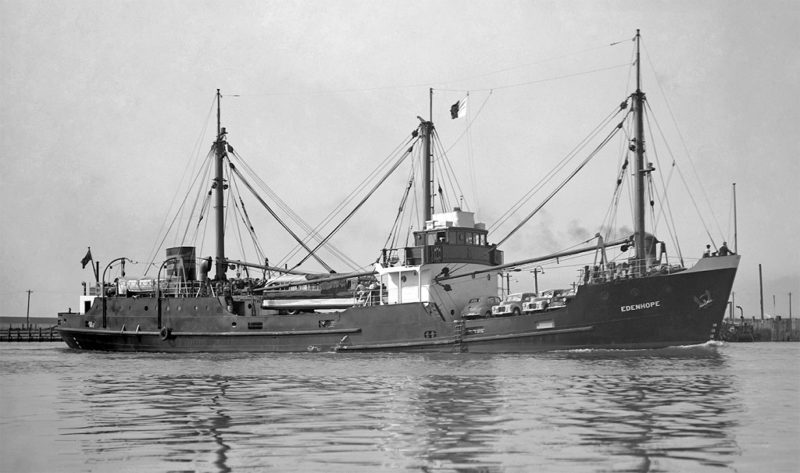
SHIPBUILDING and SHIP REPAIR
The shipbuilding industry of Newcastle was important at the three yards of the Walsh Island Dockyard and Engineering Works, the State Dockyard, and the FORGACS shipyard, the latter having concentrated on warship construction recently with an order for the Huron Class of minehunters. The foundation stone of the Walsh Island Dockyard and Engineering Works, also known as the Government Dockyard, was laid on 14th June 1913 by Hon. A. Griffiths, Minister of Public Works after the Cockatoo Island State Dockyard had also been taken over in February 1913 at Sydney. The yard covered 145 acres with a river frontage of 2,200 feet for shipbuilding, ship repair, bridge building, building of railway rolling stock including carriages, welded steel pipelines and general engineering work. The yard was located opposite to the Broken Hill Proprietary Company steelworks at the junction of two arms of the Hunter River. The equipment of the yard featured twin Sir William Arrol cantilever hammer head cranes with a 95 feet working radius, many covered fabrication shops each equipped with twin ten tonnes travelling cranes, five building berths, a drawing office of 3,300 square feet in area, an extensive mould loft to lay out the design lines of ships, a power house with air compressors, hydraulic pumps and electrical motors, plate hole punchers for rivets to be inserted in the holes of plates, heavy and light shearing machines, keel bending machines, drills and counter sinkers, an extensive steel stockyard, and a large guillotine capable of shearing steel plates of ten feet in width and one inch thickness.
The yard built six cargo ships of 6,100 grt of the ‘E’ class in Euralia, Ennogera, Ellaroo and three others, coasters, Sydney Harbour ferries, dredgers, tugs and trawlers, in addition to pumping plants, pipelines, cranes and machinery of every description. A large consignment of six feet diameter steel pipes was completed in 1929 for the Newcastle Metropolitan Water Supply. A Floating Dock was completed in December 1929, and had been launched down the slipways in three sections, with the forward section launched on 15th March 1929 by Mrs. Buttershaw, wife of the Minister for Railways and Works, the centre section was launched on 5th October 1928 by Hon. T.R. Bavin, Premier of New South Wales, and the aft section last on 1st September 1929. These three sections could operate individually or together, e.g. if two sections were in use ships of up to 420 feet in length could be docked with a dock lift of 11,000 tons, while if all three sections were used ships of up to 630 feet in length could be docked with a dock lift of 15,000 tons. The Floating Dock cost £410,000 with a subsidy of £135,000 from the Commonwealth Government. The dock had a clear width entrance of 82 feet, and was similar in most respects to the Singapore Floating Dock. The first ship to enter the dock was the ‘E’ class engines ‘midships steamer Ellaroo in December 1929.
The Walsh Island Shipyard also built bridges to cross the Katherine River, Richmond River, Kyogle River and Cooks River, as well as steam railway locos and carriages. The yard became a victim of the Depression in 1933, with yard workboats sunk at their jetties, and was closed at the end of 1933 and was dismantled shortly before the outbreak of World War II. If dismantling had not gone ahead, there would have been no need to build a new shipyard that became the New South Wales State Dockyard.
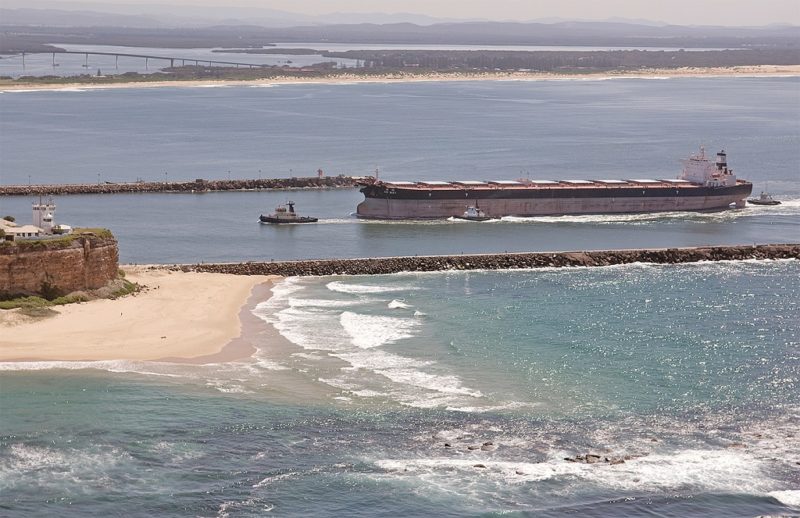
In 1942, the New South Wales State Dockyard opened on the site of the Government Dockyard at Dyke Point that had closed down in 1933 during the severe world Depression. The official name was the New South Wales Government Engineering and Shipbuilding Undertaking, but was universally referred to as the State Dockyard. The shipbuilding site was of 27 acres in area, and the ship repair site of three acres, both located in Carrington Precinct. The Dockyard launched its first ship, the destroyer HMAS Strahan in July 1943 followed by her sister HMAS Condomine, together with 22 merchant ships for the U.S.A. and had repaired 600 ships during the war. The 15,000 ton Floating Dock from the Walsh Island Yard was relocated at the yard in 1943 to repair ships damaged during World War II, but was broken up in 1977 and replaced by another floating dock built in Japan and named Muloobinba, which was sold overseas in 2012. The yard had three berths for building vessels up to 550 feet in length, and there were also two patent shipways for repair work with a cradle length of 234 feet, and a lift capacity of 1,250 tonnes. Ships built by the State Dockyard included:-
- Cargo ships Dorrigo, Dubbo, Delunga, Denman, and Dongarra between 1946 and 1950
- Cargo ships Townsville, Woomera, Warringa for Huddart Parker Ltd. between 1952 and 1953
- Sydney Harbour ferries Kooleen and Koojarra in 1956
- Ore carrier Iranda of 1957 for ANL of 7,276 dwt
- Yellow hulled passenger ferry Princess of Australia launched in November 1958 for ANL
- Ro-ro Bass Trader in 1961
- Lighthouse Supply ships Cape Don, Cape Moreton and Cape Pillar of 2,190 grt with a crew of 39 and a service speed of 12.5 knots during 1962 to 1964
- Suction dredgers H. E. Street 836/49, Richard Vowell 1,047/50 and John Main 681/62 for New South Wales Government, Dept. of Public Works
- Burns Philp cargo ship Moresby for the trade to Papua New Guinea
- Container ship Kooringa in May 1964 for Associated Steamships of Australia, 6,755 dwt, 290 TEU, and 16.0 knots service speed
- BP Australia tankers BP Endeavour and BP Enterprise in 1967/68
- Ro-ro Australian Trader for ANL of Australia in 1969
- Ro-ro Darwin Trader in 1970
- Dredgers Geopodes and W.D. Resolution in 1971 for Dutch owners and Westminster Dredging
- Ro-ros Lysaght Endeavour and Lysaght Enterprise in 1973
- Howard Smith cargo ship Express in 1974
- Caltex tanker John Hunter in 1975
- Ro-ro Bass Trader II in 1976
- Bulkers Flinders Range and Selwyn Range of 27,000 dwt in 1977
- A series of green hulled Sydney harbour ferries named Freshwater, Queenscliff, Narrabeen, Collaroy, Lady Cutler, Lady Woodward, Lady Street, and Lady Herron with the last completed in 1979.
- A series of dredgers, fishing trawlers and tugs were then completed between 1980 and 1985, with the State Dockyard then closed down
- and the site cleared.
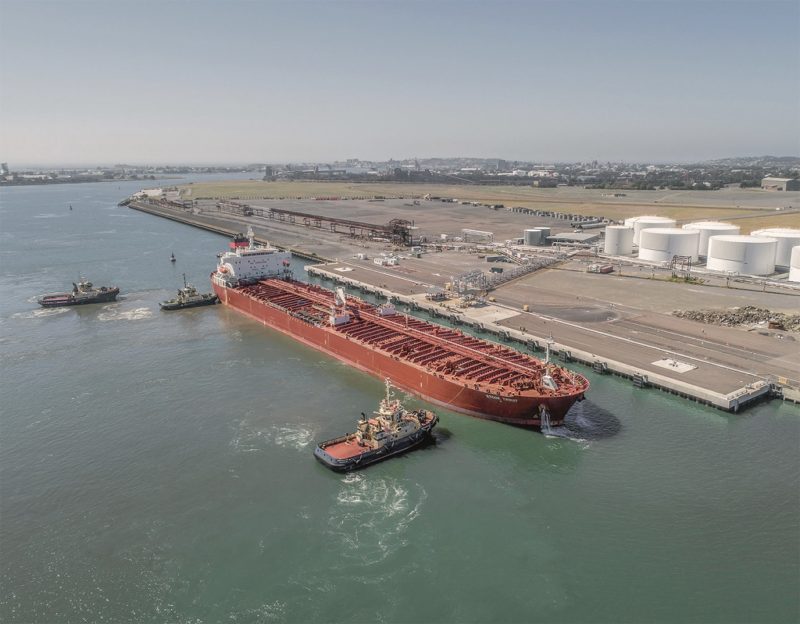
MARITIME DISASTERS at NEWCASTLE
On 12th July 1866, the steam paddle ship Cawarra was on its voyage from Brisbane to Newcastle carrying 60 passengers, but was caught in a storm as it made its way into Newcastle harbour. All 60 passengers were lost, but a crew member named Frederick Hughes was the sole survivor.
The French four masted barque Adolphe was wrecked on 30th September 1904 on the Oyster Bank at Stockton when she attempted to enter the harbour in a gale from Antwerp. Two tugs were sent to assist her but could not hold her in a strong gale.
A regular ferry service ran across the Hunter River from Stockton to central Newcastle from 1846, but it came to grief on 9th August 1934 when a collision occurred with a coastal cargo ship named Waraneen. The ferry was called Bluebell, an innocuous enough name, but when she sank in the middle of the river three lives were lost and fifteen passengers were admitted to Newcastle Hospital, with two people suffering severely from immersion in the river. The blame for the collision lay with the Master of the ferry.
The bulk carrier Sygna had been launched by Austin & Pickersgill in two halves on 25th July 1967 at Sunderland, which were towed around to the Tyne to be joined together with a completion date of 30th November 1967. She was of 39,053 grt and 52,950 dwt with dimensions of overall length of 712.8 feet, moulded beam of 98.1 feet, depth of 55.6 feet, and a loaded draft of 40.7 feet. She had a service speed of 15 knots from a seven cylinder 2SA B & W oil engine of 16,100 bhp, and was owned by J. Ludwig Mowinckels Rederi of Bergen. She became a shipwreck on Stockton Beach at Newcastle on 26th May 1974, and her crew of 31 from Bergen were rescued by helicopter.
She was refloated on 6th September 1974 by the tug Lady Vera but immediately broke in half, with the bow section towed to nearby Port Stephens and then 18 months later to Japan for breaking up, arriving on 26th February 1976. The stern section grounded again and remained as a landmark on Stockton Beach for over 40 years, until it finally disappeared from view in 2016. A tumultuous storm had closed both of the ports of Sydney and Newcastle with huge swells pummelling the coast, and a warning was issued by Nobbys Head Signal Station to all ships anchored off the coast to put to sea, but the Master of Sygna, Ingolf Lunde aged 57 years, decided to remain at anchor. The storm had gusts of over 70 mph with the fury lasting over 3 hours and doing incredible damage to the region around the port. Lives were lost, houses were demolished, 200 cars were swept away into the sea, a large timber church was moved over six metres off its foundations, and a 200 metre jetty was destroyed. The Stockton ferry wharf was partly demolished with the pieces sunk in the harbour. Six ships in Newcastle harbour snapped their shore hawsers and careered around the harbour and were chased by tugs, these were the ro-ro Brisbane Trader, tanker Express, Dutch cargo-liner Man Lloyd, tanker Cherry, bulker Rudolf Olsen, and a Japanese bulk carrier. Sygna had arrived off the port five days earlier to load coal for Europe.
The red hulled Lauritzen bulker Pasha Bulker was aground on the seaward side of Nobbys Beach on 8th June 2007. A heavy vicious gale had hit Newcastle with gusts of over 60 mph and waves and swell of over seven metres. Some 56 ships were off the port at anchor awaiting to enter and load cargoes of coal. A red alert warning was issued at midnight by Nobbys Head Signal Station, and 15 ships had up anchored and put to sea by 0200 hours, and by 0700 hours only nine ships remained at anchor. The Master of Pasha Bulker tried to lift her anchor and make headway out to sea but was pushed back on to the beach and grounded at 0950 hours. Two further ships, Sea Confidence and Betis, almost grounded at the same time as they clawed their way out to sea. The Master of Pasha Bulker may have committed an offence of Negligent Navigation under NSW Water Traffic Regulations, but was not prosecuted, and his ship was later refloated on 2nd July 2007, having arrived in the anchorage on 23rd May 2007. Major repairs to her hull bottom were done in Japan.

PORT OF NEWCASTLE BERTHS
The Port of Newcastle covers an area of 792 hectares with 200 hectares of vacant land for further development. The port is a very busy one, located at position 32°55′ South, 151°45′ East, with an arrival or departure of a large ship every hour i.e. 24 vessel movements in one day. Vessels have to obey strict regulations regarding pilotage, ship handling and live data on channel depths in all parts of the port, as well as dangerous cargoes notification and ship maintenance working at least 48 hours before arrival, and also bunkering notification, and diving notification. The Newcastle Harbour Master has powers under the Marine Safety Act of 1998 to direct and control the time and manner in which all vessels may enter or leave the harbour. This is to give safety in a range of static and dynamic data regarding port conditions, river conditions, promulgated depths and various safety environmental conditions. Harbour Passage Plans must be strictly adhered to by all Masters and deviations from course for any reason will not be tolerated. Pilots are transferred from Pilot cutters or from helicopters at some distance outside the twin breakwaters. The berths in the Port of Newcastle in the city precincts of Carrington, Mayfield, Walsh Point and Kooragang are as follows:-
The Port of Newcastle is a river port with a tidal range of two metres, the main channel has a design depth of 15.2 metres, and all berth depths are subject to change. The Dyke coal loading berths each have a design loading capacity of 25 million tonnes per year, while the Kooragang coal loading berths each have a designed loading capacity of 64 million tonnes per year. Petroleum tankers of LR2 design of 245.0 metres overall depth, and moulded beam of 43.0 metres, are the maximum size of tanker for the port. All dry bulk and cargo berths have full access to local and national rail systems.
Fire on the conveyor belts of the giant shiploaders at Kooragang are a hazard when they run in a heated state or in hot weather e.g. Kooragang 2 coal loader caught fire on 24th August 2018 with two fire crews called out to extinguish a fire that had started in the morning and took some hours to extinguish. No ship was alongside in this incident, but an earlier conveyor belt fire on a shipunloader, with a BHP ship alongside and unloading iron ore, spread to the ship and severely damaged her.
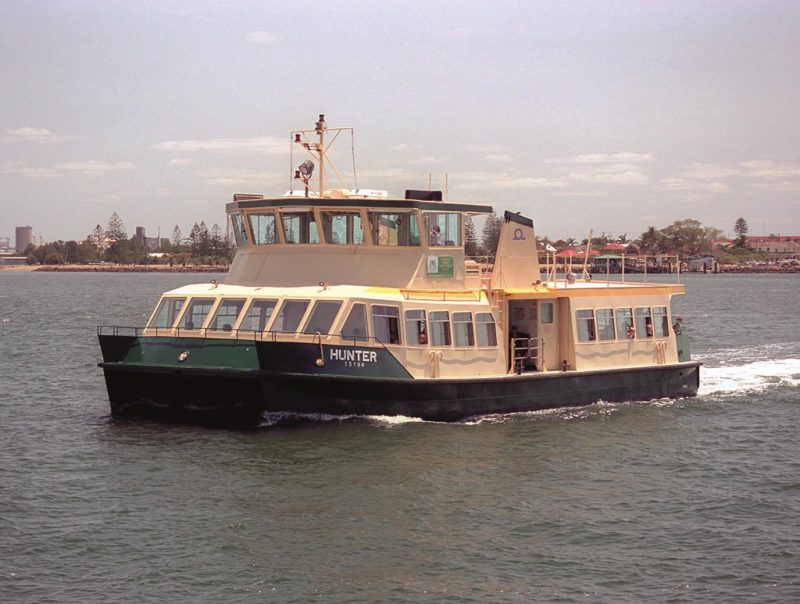
NEWCASTLE CRUISE TERMINAL
There are two cruise terminals in the port, the main Carrington Cruise Terminal for large cruise ships, while smaller cruise ships can dock at Queen’s Wharf, the port ferry terminal. The Carrington Cruise Passenger Terminal covers 3,000 square metres, and has facilities for passenger check in, shopping, and car parks for passenger drop off and pick up. A budget of Australian dollars 12.7 million was available in 2018 for bollard and other upgrades to the existing terminal and for the construction of a new cruise terminal. Some 16 cruise ships called at the Carrington Cruise Terminal in season 2018/19, and the same number in season 2019/20, including cruise ships of P & O Cruises (Australia), Princess Cruises, Crystal Cruises, Royal Caribbean International (RCI) Cruises, Seabourn Cruises, Silversea Cruises, Regent 7 Seas Cruises and other international cruise lines. The number of cruise passengers numbered over 30,000 in each of these two cruising seasons, but the number of passengers for season 2020/21 was severely curtailed by stringent Australian COVID-19 rules, with the Carrington Cruise Terminal closed in October 2021 during a very serious outbreak of the virus throughout Australia.
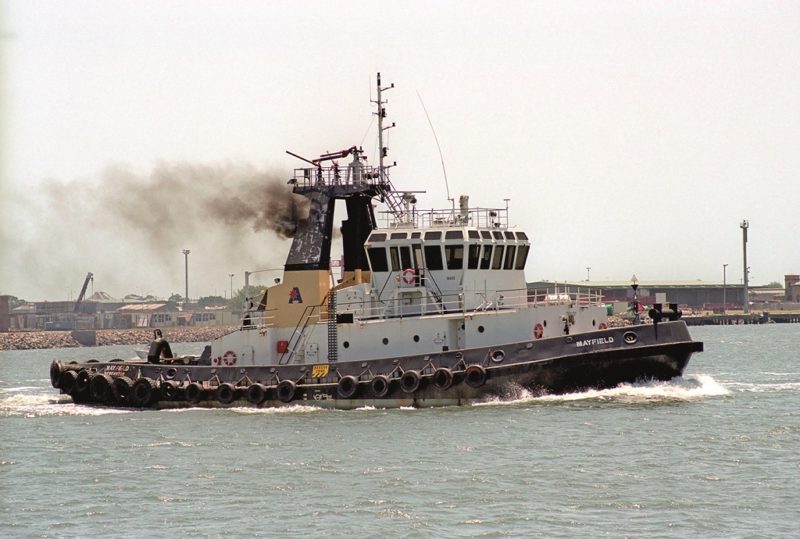
TWO RESTORATION PROJECTS IN THE HARBOUR
The Macquarie Pier on the south side of the harbour was built in 1818 as a breakwater between the mainland and Nobbys Island, and gave shipping a much safer approach into the port. A four month long major makeover for the pier lasted from August to completion on 21st December 2020, and cost $3 million by the Port Authority of New South Wales. The finance came in the form of $2.3 million from the New South Wales Government, $0.5 million from the Newcastle Port Community Fund, and $0.2 million from the Port of Newcastle. Visitors to this historic pathway now benefit from a restored and widened walkway of 900 metres in length, with sandstone seating, maritime style fencing, and interpretive features. At the foot of the high Nobbys Head, a new paved area has been created for visitors to relax, enjoy a coffee and sandwich from mobile cafes, and watch the activity of the ships being escorted in and out by tugs over the long two mile approach channel.
The William the Fourth early steamship was built in 1831 by the old Deptford Shipyard at Clarencetown to transport passengers and produce between Sydney and settlements along the coast during the early days of the development of New South Wales. She operated this service for over thirty years before being sold to owners in Hong Kong. A replica ship was built in 1987 in Newcastle and was used for public cruises and private charters on the Hunter River and in ports along the NSW coast. This coal fired replica steamship operated for fourteen years, but was put out of service in 2001 due to the high cost of bringing the vessel up to modern standards. She was given a new diesel engine, and with a green hull, yellow bowsprit, twin brown masts with white uppers, and a black funnel with a central grey band, she returned to service in April 2021. The Newcastle Harbour Master gave full permission for a Port Authority Marine Pilot to captain the vessel on her trial run. The vessel achieved a commercial licence, and operates in summer.
POSTSCRIPT
Oil spill exercises are carried out annually at berths in Newcastle harbour, and staff from the port responded to an oil spill by the container ship APL England off the New South Wales coast in June 2020. The six ports of the Port Authority of New South Wales each have their own individual characteristics and form a powerful State grouping of ports.

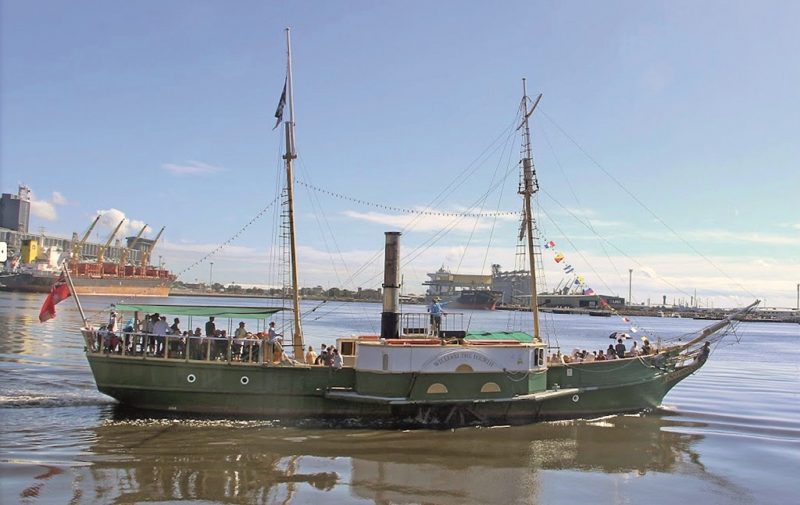
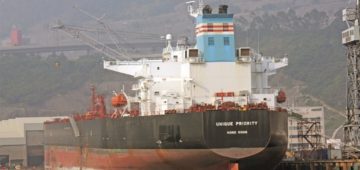



Comments
Sorry, comments are closed for this item